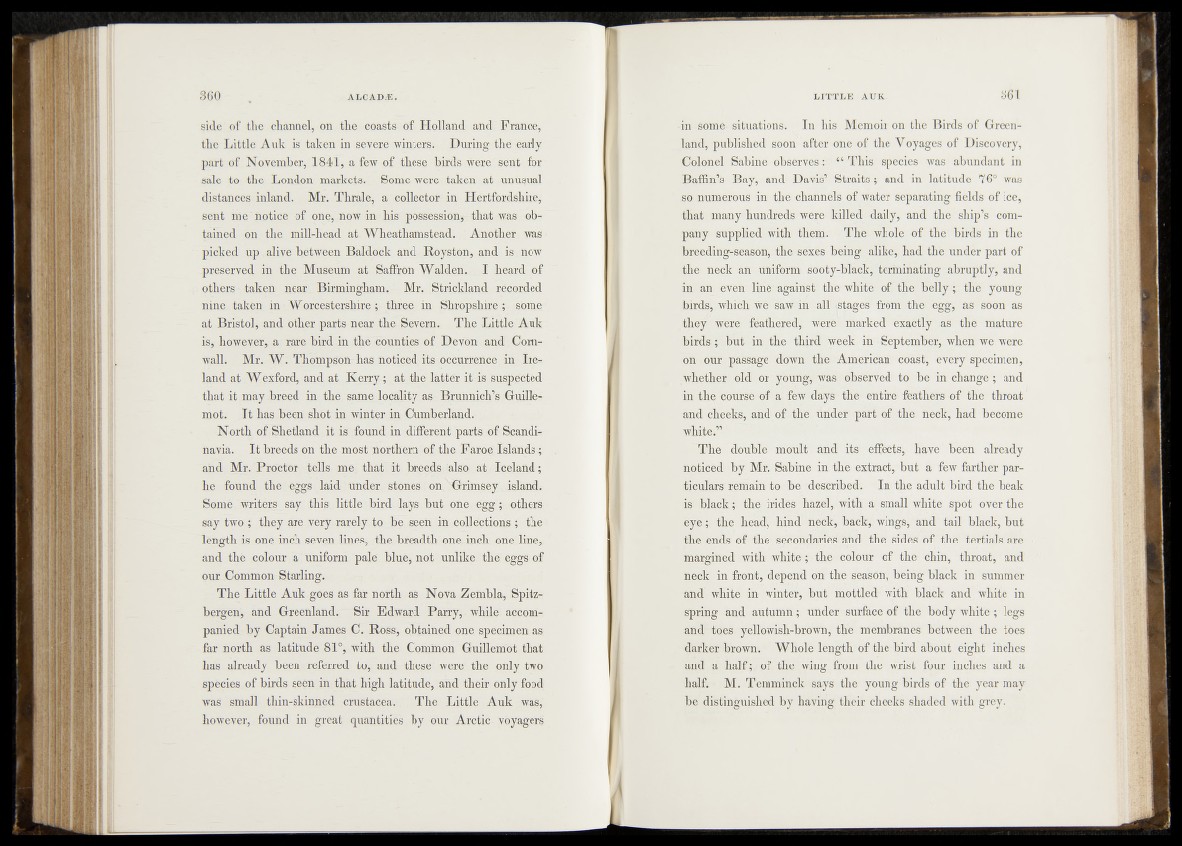
side of the channel, on the coasts- of Holland and France,
the Little Auk is taken in severe winters; During the early
part of November, 1841, a few of these-birds were ' sent for
sale to the London markets. Some were taken at unusual
distances inland. Mr. Thrale, a collector" in Hertfordshire,
sent me'notice of one,.now in his possession^-that was, ob?
tained on the. mill-head at Wheathamstead. Another was
picked up ..aliv'odiétween BaTdock. and - Roystraj-, and HS now
.preserved in the Museum at Saffron Walden. I heard of
Others •. takeùv near. Birmingham. Mr. Strickland. rëcQfded
nine-taken in Worcestersh ireth ree,in Shropshire ^jsbme
at Bristol^ and other parts near the^evern.-; . The -Little 'Auk
i%„however, a'rare bird in th e ^ o i^ tp ^ of DeVifn .andi G@mr
wall. Mr. W . Thompson-has riotig^dvfl^^ in ' Ireland
at Wexford, arid-at Kerry-; at gibe lattér itpk 'suspected
that it mayr-breed in the same locality .as- B ru n n ic^ Guille-
mot: I t has.beçri sbot in wmterq^ C!umbffir^fcdfeji>
North of,Shetland • w|s~ found in'different parts-of Scandinavia.
I t breeds on tbe most^orthern’pfi th%f^a^oeif§lands ;
arid Mr.'Proctor tells me\ that" it breedst|alsofi at I&elartd :
he found .the I eggs laid under. stones^h.NSbim^ey_visten^!'
Somé writèrs_say tfiSa^ttle bird lays but .frfi'duflrgf:lplwM|
say two i .they are very^rarely-to be ^ ]rfg in the
length is one inchrS'evên lines^thejbfgadth onej^pfe;ofiMlines
and the .colour a ; uniform pale blue, no,fc unlike the'-içggsf,©!
ourJSomm on^Starling.
The- Little Aukgôes'às far north as Nova Zembla, Spitz-
bergeri, and Greenland. ' Sir Edward Parry,. wlfile! accompanied
by Captain James C. Ross, ojb,tained lorip. specimen? as;
far north as latitude S iP ^ ith the Corrimori Guillemot that
has already been-.referred ttrg and these' were the orily two
species of birds s.efriin that high latitude, arid their only food
was small thin-skinned Crustacea.. The Little Auk was,
however, found in great quantities by bur Arctic-Voyagers
in some- situations. In his Memoir on the Birds of Greenland,
published soon after one of the Voyages of Discovery,
Colonel Sabine observes “ This species was abundant in
Baffin’s Bay, -and Davis’ Straits; and in latitude 76° was
so numerous in the channels of water separating fields of ice,
that many hundreds were killed daily, and the ship’s company
supplied with them. The whole of the birds in tbe
breeding-seasbni’. the sexes being alike, bad the under part of
tfche*.' rieck an uniform sooty-black, terminating abruptly, and
in p®^evebf. finer against’.: tie white of the belly ; the young
-birds, which? we Saw in - all ^tages from the egg, as soon as
^hoy fea£hefe%. wefk' marked e x a c tly as the mature
birds^bilt-^-in .the third^&ek- in - September, when we were
on our ffaksagef down- tbe American Coast, every specimen,
^whether: old«'or'Wfufig, was; observed to be* in change ; and
in ‘tliefcdifec offa few days the entire feathers of the throat
and- cbeels, and ^ the under: part of the neck, had become
white.” ’
PpfEehe moul^^nd its effects, have been already
irioti'ced by Mr. Sabina'in the extract, but a few farther particulars
remain to-. b'e’|described. In the adult bird the beak
H -black; p© irides hazel, with a^small white spot over the
*Jb.ye.;^tIie' #ead^.hind neck, back, wings, and tail black, but
the ends of the ^poridaries and the sides of the tertials are
margined with white ;^th‘e:#®l|>;&r of the chin, throat, and
neck in front, depend on the seasdtf, being black in summer
and white in winter, -but mottled with black and white in
spring and autumn; under' surface of the body white ; legs
and toes yellowish-broVn, the membranes between tbe toes
darkefobirown.' WholeTength lof the bird about, eight inches
and a h a l f .of. the wing from thd/ wrist four inches and a
half. - M. Temminck says the young birds of the year may
b$ dfet&nguished by having their cheeks shaded with grey.